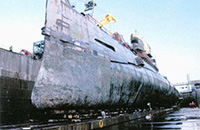Just one year after his mesothelioma diagnosis and two major surgeries, Shaun says he has a great support system. He’s also sharing some advice for others who are on their own mesothelioma journey.
Bremerton Puget Sound Naval Shipyard Asbestos Use
Workers at the Bremerton Naval Shipyard in Washington helped build U.S. military ships. But many workers were exposed to asbestos. Years later, some developed mesothelioma and other diseases after long-term exposure without proper safety measures.

History of Bremerton Naval Yard and Asbestos
The U.S. Navy opened the Puget Sound Navy Yard at Point Turner in 1891. Starting with 190 acres, the base grew into a major shipbuilding and repair center. It now covers more than 1,300 acres, making it the largest shipyard on the West Coast. Navy crews used massive amounts of asbestos products, especially before the 1970s.
Shipbuilders used asbestos in nearly every Navy vessel built before the late 1960s, putting thousands of workers at risk. At the Bremerton shipyard, workers like insulators and boiler operators often breathed in the highest levels of asbestos fibers. More than 12,000 people, including many civilian defense workers, have worked at the yard. Studies show shipyard workers who inhaled even moderate amounts of asbestos were about 4 times more likely to die from mesothelioma.
The Navy kept the Bremerton yard operating through wars, downsizing and the shift to nuclear-powered ships in the 1960s. Workers and nearby residents have reported major health problems, and regulators have fined the site many times for dangerous pollution. Many people continue to suffer from asbestos-related illnesses like mesothelioma, lung cancer and asbestosis.
Asbestos Superfund Designation
In 1993, the U.S. Environmental Protection Agency added the site to the Superfund list because of its severe pollution, including asbestos. Today, the EPA ranks it as the 17th most toxic site in the country.
The EPA’s Superfund plan for the Puget Sound Naval Shipyard explained cleanup would take a long time. Since the site still contains dangerous materials above safe levels, the EPA said it would need long-term monitoring. The Puget Sound Air Pollution Control Agency helped push the cleanup forward, fining the shipyard $300,000 for breaking asbestos safety rules.
Experts warned shipyard leaders in the mid-1940s that asbestos could harm workers’ health. Still, a Bremerton Naval Yard spokesman later said, “During the time of their disposal … no one fully understood how dangerous these materials were.”

Learn about your diagnosis, top doctors and how to pay for treatment.
Get Your Free GuideWhy Was Asbestos Used at the Bremerton Naval Shipyard?
Shipbuilders heavily used asbestos because it resists heat and corrosion. Workers used it to insulate boilers, steam pipes and incinerators. Many workers, like machinists, boilermakers and painters handled asbestos directly between the 1930s and 1980s.
The U.S. Navy once required shipbuilders to use asbestos for fire protection. The Navy used more asbestos than any other military branch. This rule put thousands of shipyard workers at risk of asbestos exposure.
How Were Bremerton Shipyard Workers Exposed to Asbestos?
Workers at the Bremerton Naval Shipyard often did their jobs in small, cramped areas like engine rooms and below deck, where airflow was poor. Many workers cut, sanded, sawed or ground down pipes and insulation wrapped in asbestos. They usually didn’t wear masks or protective gear. Safety rules were weak at the time, so most people didn’t know how dangerous asbestos really was.
Higher-Risk Occupations at Bremerton Naval Shipyard
- Boilermakers
- Electricians
- Insulators
- Machinists
- Maintenance workers
- Painters
- Pipefitters
- Welders
Once toxic asbestos fibers got into the air, they spread easily through the shipyard and into the ships that workers were fixing. Occupational asbestos exposure put thousands of veterans and civilian workers in danger. Many later developed serious diseases like mesothelioma, lung cancer and asbestosis.
Bremerton Shipyard Asbestos Lawsuits
The Bremerton Naval Shipyard has been linked to many asbestos-related lawsuits. Because the Navy has some legal protections, most asbestos lawsuits focus on contractors and manufacturers that supplied asbestos products to the shipyard. These companies made materials like insulation and piping that exposed workers to hazardous asbestos dust.
Aaron Munz, director of the Veterans Department at The Mesothelioma Center, says, “Navy veterans have the highest risk of developing mesothelioma because of how much asbestos was on board Navy ships in the 20th century. Navy veterans were exposed to asbestos 24 hours a day, 7 days a week, anytime that they spent time on a Navy vessel.”
Asbestos Lawsuits Linked to Bremerton Naval Shipyard
- Court recognizes risk from indirect asbestos exposure: Gary D. Allen worked at Bremerton for 25 years before dying from asbestos-related lung cancer. His son sued Uniroyal, the company that took over United States Rubber, which supplied asbestos insulation. A trial court dismissed the case, but an appeals court reversed the decision. The court said even indirect exposure from “drifting” asbestos dust could be enough to prove harm.
- Legal duty to warn workers about asbestos: Vernon Braaten worked his entire career at Bremerton as a pipefitter and regularly handled asbestos-covered pipes. He sued the manufacturers and distributors of the asbestos piping materials. The court ruled in his favor, stating that companies had a legal duty to warn workers about the dangers of asbestos.
Between 2002 and 2009, the Department of Labor received 17 safety complaints about the shipyard, including several involving asbestos. Veterans and civilian workers who got sick from asbestos exposure may still be able to file lawsuits or seek help from experienced asbestos lawyers.
People who worked at Bremerton have other legal options, too. Some may qualify for compensation through an asbestos VA claim or the Longshore and Harbor Workers’ Compensation system. A VA-accredited claims agent can help you understand your options.
Recommended Reading


